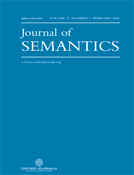-
Views
-
Cite
Cite
Jo-Wang Lin, Time in a Language Without Tense: The Case of Chinese, Journal of Semantics, Volume 23, Issue 1, February 2006, Pages 1–53, https://doi.org/10.1093/jos/ffh033
Close - Share Icon Share
Abstract
This paper outlines a framework of the temporal interpretation in Chinese with a special focus on complement and relative clauses. It argues that not only does Chinese have no morphological tenses but there is no need to resort to covert semantic features under a tense node in order to interpret time in Chinese. Instead, it utilises various factors such as the information provided by default aspect, the tense-aspect particles, and pragmatic reasoning to determine the temporal interpretation of sentences. It is shown that aspectual markers in Chinese play the same role that tense plays in a tense language. This result implies that the Chinese phrase structure has AspP above VP but no TP is above AspP.



